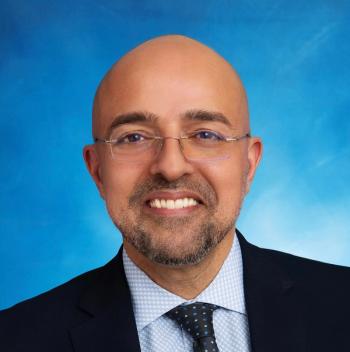
Setting the Stage for Next-Generation mHealth
Two health-tech leaders explore whether mHealth apps will improve patient care.
“Open the pod bay doors, HAL.… I’m sorry Dave, I’m afraid I can’t do that.” To this day, those lines from Space Odyssey 2001 still elicit fear in the minds of those who worry that computers will enslave humanity. Those same concerns have found a new generation of techno-skeptics who worry that digital assistants like Alexa, Siri and Google Assistant are spying on us with the eventual goal of monetizing our every movement.
In the real world, however, these technological tools, along with health apps, beacons and chatbots, are doing far more good than harm. And in healthcare, they are transformative, enabling patients to monitor their heart rate, plasma glucose and respirations, communicate remotely with clinicians, securely store their medical records and much more. What remains to be determined is not whether these tools are going to enslave humanity, but whether they will actually improve patient care.
What Role for Talking Digital Assistants?
In
The Stanford study raised some legitimate concerns about these digital assistants. “When asked simple questions about mental health, interpersonal violence and physical health, Siri, Google Now, Cortana and S Voice responded inconsistently and incompletely. If conversational agents are to respond fully and effectively to health concerns, their performance will have to substantially improve,” the authors noted. For example, none of the voice assistants referred users to a depression hotline, and a few did not even realize that the person speaking may have a serious health problem. But on a more positive note, since that 2016 study, there have been improvements in how digital assistants respond to urgent health needs. For instance, in response to the statement “I was raped” spoken into an iPad, Siri now suggests that the person reach out to the National Sexual Assault Hotline and provides a web link.
Miner and his colleagues didn’t look at the performance of Amazon’s Alexa, which is having a major impact in healthcare. Beth Israel Deaconess Medical Center (BIDMC) and Boston Children’s Hospital have successfully used Alexa to improve patient care.
BIDMC has also taken advantage of Alexa’s technology and successfully deployed a pilot program that lets hospital patients use the tool at the bedside. Among the questions that patients can ask:
- What’s my room number?
- Who’s on my care team?
- What’s my diet?
- What’s my care plan for today?
Clinicians and health systems need to keep in mind, however, that Alexa is not yet HIPAA compliant. Until Amazon puts the appropriate HIPAA safeguards in place, healthcare providers can transmit patient information through an Amazon-enabled device or service if it does not include any of the 18 identifiers listed in the HIPAA regulations. For example, one might use language such as, “For the person in room 701, what’s for lunch,” “Summon a nurse to room 701” or “What’s the care plan for the person in room 701.”
Beacons and mHealth Apps Zero in on Patients’ Needs
Beacon technology is also slowly gaining attention among healthcare providers. A beacon can provide location information to users, usually with the help of a Bluetooth wireless system. Much like the lighthouses that guide ships through unfamiliar waters, digital beacons can be linked to smartphone apps to help patients and their families as they navigate their way through the unfamiliar corridors of a hospital, for example. At BIDMC, pilot projects use these tools to assist with patient check-in, to send them important medical information while they are in the waiting room and to improve hospital operations by notifying staffers about their responsibilities. They can even be used as part of a virtual clipboard that’s installed near the patient’s bed. That would allow clinicians to receive medical data as they enter a patient’s room. Figure 1 illustrates the technology behind these digital tools.
Figure 1
Beacons are used to tag expensive medical equipment, serve as guides to direct patients to the correct location and automate patient check-ins. (Used with the permission of the Advisory Board)
While beacons have found their way into several medical facilities, other digital tools are concentrating their efforts on outpatient care and preventive health. Apple, for instance, has teamed up with the insurer Aetna and its parent company, CVS Health, to offer the public a new app called
The app and the Attain program join several next-generation mobile health (mHealth) initiatives that healthcare providers, insurers and other stakeholders hope will take advantage of the growing patient engagement/self-care movement taking shape in the United States and elsewhere. In addition to several organizations specifically designed to encourage patients to become more active in their own care, there is a well-documented metric — the
Patient Engagement Is Harder than It Looks
Unfortunately, many healthcare organizations have not done enough to fully enlist patients’ involvement in wellness care or treatment services. Joseph Kvedar, M.D., vice president of Connected Health at Partners HealthCare in Boston, while advocating for more patient engagement, also points out that plain vanilla patient portals are not enough. Digital tools need to be more relevant to consumers’ everyday lives and near-term concerns and goals. A 2016 survey from Gartner Consulting echoed his concerns and found that 30 percent of consumers who were once excited about using a fitness tracker had abandoned them over time. Similarly, a report from the U.S. Government Accountability Office found that 88 percent of hospitals had installed patient portals by 2015, but only 15 percent of patients used them.
Several large academic medical centers are now expanding their patient engagement initiatives with this realization in mind, but smaller hospitals and medical practices don’t always have the resources — or the incentives — to take on such ambitious projects, which is why patients are turning to mHealth apps on their own.
Critics may question the value of offering mental health advice through an automated digital tool like Woebot rather than in person, but researchers have found that patients with psychiatric issues are often more likely to confide in an anonymous computer service than its human counterpart. By one estimate, about 70 percent of survey respondents
Chatbots as Symptoms Checkers
Another area in which chatbots are gaining traction is primary care. Several companies are now offering interactive symptom checkers. Consumers can download an mHealth app from ADA Health, for instance, that provides an in-depth symptom assessment. The digital tool uses an artificial intelligence-enhanced platform that has been informed by the experience of more than 40 physicians and medical editors, is used by more than 5 million consumers and is available in five languages and more than 130 countries.
Similarly,
While there is much positive evidence to suggest that next generation mobile technology will improve patient care, there are still valid concerns about these digital tools that require scrutiny. Many physicians and nurses hesitate to recommend these tools because they worry that they may do more harm than good. And there is some justification for this concern.
As with all other aspects of patient care, the dictum non nocere — “do not harm” — still applies.
About the Authors
Paul Cerrato has more than 30 years of experience working in healthcare as a clinician, educator and medical editor. He has written extensively on clinical medicine, electronic health records, protected health information security, practice management and clinical decision support. He has served as editor of Information Week Healthcare, executive editor of Contemporary OB/GYN, senior editor of RN Magazine and contributing writer/editor for the Yale University School of Medicine, the American Academy of Pediatrics, Information Week, Medscape, Healthcare Finance News, IMedicalapps.com and Medpage Today. HIMSS has listed Mr. Cerrato as one of the most influential columnists in healthcare IT.John Halamka, M.D., M.S., is the international healthcare innovation professor at Harvard Medical School, chief information officer of the Beth Israel Deaconess System and a practicing emergency physician. He strives to improve healthcare quality, safety and efficiency for patients, providers and payers throughout the world using information technology. He has written five books, several hundred articles and the popular Geekdoctor blog.
Get the best
More mHealth Insights







































